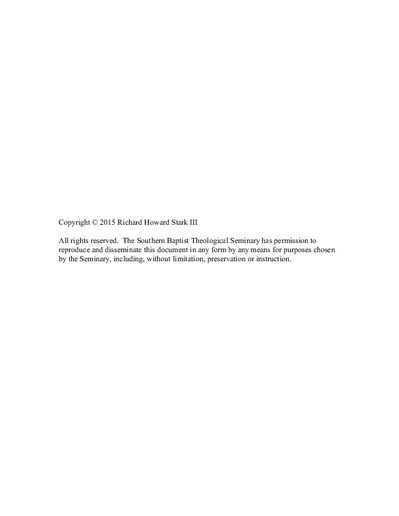| dc.contributor.advisor | Coppenger, Mark T. | |
| dc.contributor.author | Stark, Richard Howard | |
| dc.date.accessioned | 2016-01-12T18:11:49Z | |
| dc.date.available | 2016-01-12T18:11:49Z | |
| dc.date.issued | 2016-01-12 | |
| dc.identifier.uri | http://hdl.handle.net/10392/5062 | |
| dc.description.abstract | The purpose of this dissertation is to examine and evaluate Arthur
Schopenhauer’s aesthetic as it relates to the concept of Sabbath in order to see how and to what extent this aspect of his thought might correspond to a Christian view of Sabbath and thereby inform a Christian aesthetic.
Chapter 1 sets the context for the discussion of art and Sabbath within the
framework of Christianity and the Arts.
Chapter 2 offers an overview and analysis of Schopenhauer’s metaphysic,
placing his thought in the context of transcendental idealism and explaining his concept of Sabbath.
Chapter 3 demonstrates the significant role that Schopenhauer’s aesthetic plays in his philosophy, explaining how the arts provide a “Sabbath” rest for Schopenhauer.
Chapter 4 analyzes the empirical evidence that seems to affirm a sabbatical
aspect of the arts. The chapter focuses on the fields of music and art therapy in order to provide examples of the positive effects that the arts have on the emotional and physical well-being of individuals, thereby suggesting that at least part of Schopenhauer’s aesthetic theory seems to correspond to real life in measurable ways.
Chapter 5 compares and contrasts Schopenhauer’s concept of Sabbath with a
biblical concept of Sabbath. The chapter concludes that while the scriptural and the Schopenhauerian Sabbaths have several points of similarity, major distinctions exist between them. Thus, a biblical approach to understanding the arts through a sabbatical lens will significantly diverge from Schopenhauer’s system.
Chapter 6 highlights various Christian thinkers who have spoken of the arts in
a manner consistent with a sabbatical approach to the arts. The chapter focuses on Augustine, Martin Luther, Jonathan Edwards, Karl Barth, Dietrich Bonhoeffer, and C. S. Lewis. Moreover, the chapter examines several biblical passages that seem to affirm that the arts serve a rehabilitative function.
Chapter 7 demonstrates how the arts can function in a manner consistent with a biblical Sabbath. The chapter also notes the limitations of viewing art as Sabbath.
Chapter 8 summarizes the main points of the dissertation and reiterates the
value of Sabbath in a Christian aesthetic. The chapter also offers some areas for additional research. | en_US |
| dc.subject.lcsh | Schopenhauer, Arthur, 1788-1860--Aesthetics | en_US |
| dc.subject.lcsh | Aesthetics--Religious aspects--Christianity | en_US |
| dc.subject.lcsh | Arts and religion--Christianity | en_US |
| dc.subject.lcsh | Sabbath | en_US |
| dc.title | Art and Sabbath: A Christian Response to Arthur Schopenhauer's Palliative Aesthetic | en_US |
| dc.type | Electronic dissertation | en_US |
| dc.type | Text | en_US |
| dc.publisher.institution | Southern Baptist Theological Seminary | en_US |

